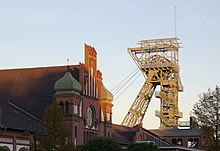Ruhr
It is considered part of the larger Rhine-Ruhr metropolitan region of more than 10 million people, which is the third largest in Western Europe, behind only London and Paris.Yet "The report of a deputation from the Transport and General Workers' Union which spent a fortnight examining the problems in the Ruhr Valley", published in The Economic Review, Volume 8, 1923, is still using the traditional term.The urban landscape of the Ruhr extends from the Lower Rhine Basin east to the Westphalian Plain and south to the hills of the Rhenish Massif.Because of its history, the Ruhr is structured differently from monocentric urban regions such as Munich, which developed through the rapid absorption of smaller towns and villages by the most significant city among them.This park connects strips of parkland running from north to south, which were developed through regional planning in the 1920s, to form a green belt between the Ruhr cities from east to west.During the Middle Ages, much of the region that was later called the Ruhrgebiet was situated in the County of Mark, the Duchies of Cleves and Berg and the territories of the bishop of Münster and the archbishop of Cologne.The region included some villages and castles, and was mainly agrarian: its loess soil made it one of the richer parts of western Germany.The development of the region into an urbanized industrial area started in the late 18th century with the early industrialisation in the nearby Wupper Valley in the Bergisches Land.[citation needed] In additional workshops in the hills, highly skilled workers manufactured knives, tools, weapons and harnesses, using water, coal and charcoal.[10] Impressive and expensive railways were constructed through the hilly Wupper region, to bring coal, and later steel, in from the Ruhr, and for outward transport of finished products.With the construction of the Cologne-Minden railway in the late 19th century, several iron works were built within the borders of the present-day city of Oberhausen.Skilled mineworkers were recruited from other regions to the Ruhr's mines and steel mills and unskilled people started to move in.[citation needed] In the March 1920 Kapp Putsch, nationalist and monarchist elements with the armed support of Freikorps units attempted to overthrow the government of the Weimar Republic.The Reichswehr, with assistance from Freikorps units, put down the rebellion in early April 1920 and re-established the Weimar Republic's control of the district.In January 1923 the whole Ruhr district was occupied after Germany failed to fulfill part of its World War I reparation payments as agreed in the Versailles Treaty.The German government responded with a policy of passive resistance, letting workers and civil servants refuse orders and instructions by the occupation forces.[18] After passive resistance was called off in late 1923, Germany implemented a currency reform and negotiated the Dawes Plan, which led to the withdrawal of the French and Belgian troops from the Ruhr in 1925.[25] During World War II, the bombing of the Ruhr in 1940–1944 caused a loss of 30% of plant and equipment (compared to 15–20% for German industry as a whole).The devastating bombing raids of Dortmund on 12 March 1945 with 1,108 aircraft – 748 Lancasters, 292 Halifaxes, 68 Mosquitos – was a record to a single target in the whole of World War II.By 1950, after the virtual completion of the by-then much watered-down "level of industry" plans, equipment had been removed from 706 manufacturing plants in the west, and steel production capacity had been reduced by 6.7 million tons.After 1973, Germany was hard hit by a worldwide economic crisis, soaring oil prices, and increasing unemployment, which jumped from 300,000 in 1973 to 1.1 million in 1975.The welfare system provided a safety net for the large number of unemployed workers, and many factories reduced their labor force and began to concentrate on high-profit specialty items.Winters have become more mild which poses a risk for crops such as apples whose blooms are vulnerable to late freezes if bud break happens too early.There are 17 different universities of applied sciences which offer students to have the opportunity to undertake practice-relevant and qualified studies in various subjects, such as economics, logistics, administration or management.The Ruhr has one of the densest motorway networks in all of Europe, with dozens of Autobahns and similar Schnellstraßen (expressways) crossing the region.Due to the density of the network, and the number of alternative routes, traffic volumes are generally lower than other major metropolitan areas in Europe.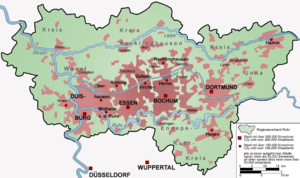

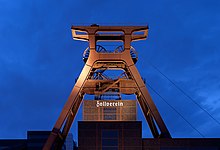






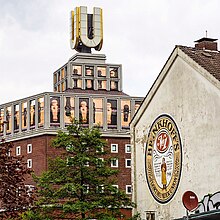


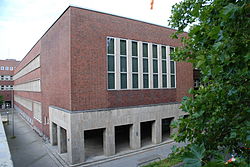

Ruhr (river)Ruhr (disambiguation)GermanyNorth Rhine-WestphaliaDortmundDuisburgBochumTime zoneGermanurban areaEuropean UnionBergisches LandRhine-Ruhrmetropolitan regionWestern EuropeLondonOberhausenBottropMülheim an der RuhrGelsenkirchenRecklinghausenEnnepe-Ruhr-KreisHellwegTeutoburg Forestimperial cityRhinelandWestphaliaDüsseldorfWuppertalEuropean Capitals of CultureEncyclopædia Britannicaoccupied the Ruhr districtInternational Labour OfficeRhenish MassifCarboniferousMunichIndustrial Revolutionbrownfield landEmscherHistory of the RuhrSt. Reinold's ChurchCounty of MarkClevesbishop of Münsterarchbishop of Colognefree imperial cityHanseatic Leagueearly industrialisationWuppercoal miningZollverein Coal Mine Industrial ComplexZeche ZollernTetrahedronblast furnacesMülheimurbanizationrailroadanthropometricSilesiaPomeraniaEast PrussiaRuhrpolenKapp PutschFreikorpsWeimar Republiccouncil republicRuhr UprisingRuhr Red ArmyReichswehrTreaty of VersaillesRuhr district was occupiedWorld War I reparation paymentsGerman hyperinflationDawes PlanAdolf Hitlersending 30,000 troops into the RhinelandWehrmachtLeague of NationsMaxim Litvinoveconomic sanctionsSoviet UnionPolandCzechoslovakiaRomaniaYugoslaviaBelgiumBattle of the RuhrOperation ChastiseOperation HurricaneBombing of German oilfacilities during World War IIbombing of the Ruhrstrategic bombing of the RuhrAlliesRuhr PocketDuisburg Inner HarbourBritish occupation zoneLevel of Industry plans for GermanyRuhr AuthorityFederal Republic of GermanyCold WarRed ArmyFulda GapEuropean Coal and Steel CommunitySaar regionmanufacturing plantsWirtschaftswundersteel crisisEuropean Capital of Cultureoceanic climateglobal warmingbow echoapplesprecipitationrelative humiditysunshine hoursWorld Meteorological OrganizationHong Kong ObservatoryList of cities in Germany with more than 100,000 inhabitantsRuhrdeutschsociolectMasuriansSilesiansOstfluchtFranceIrelandUnited Kingdom
